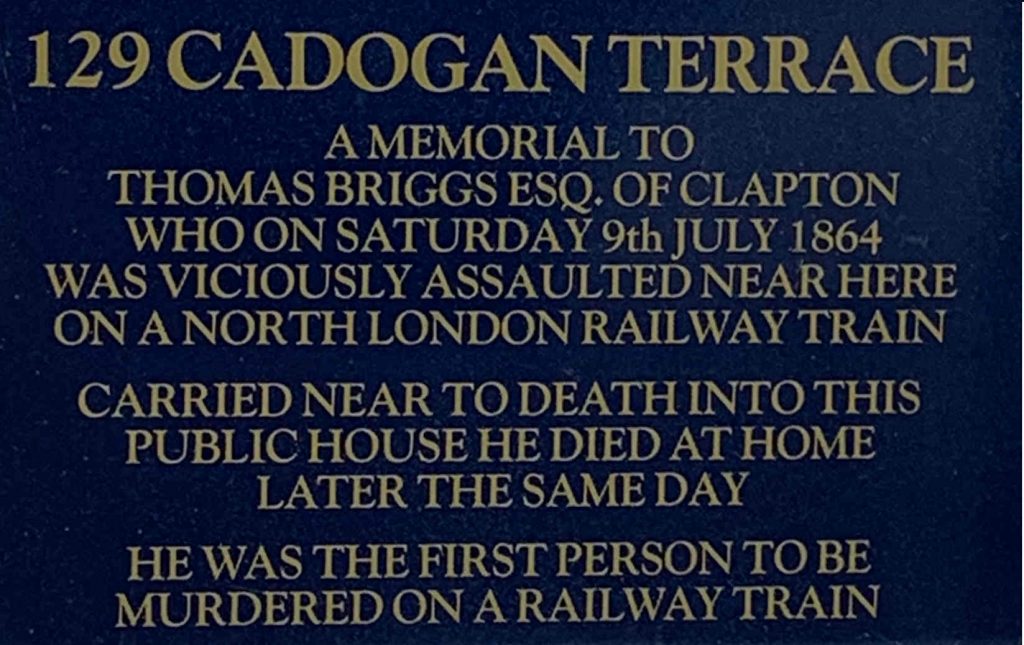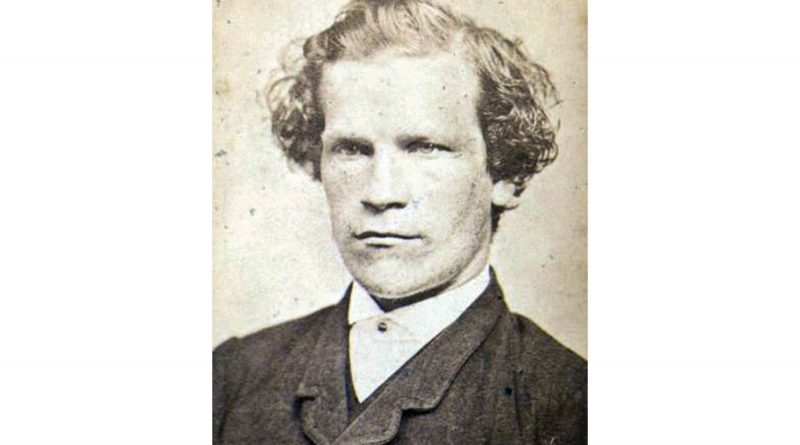Franz Müller: first murder on a British train and origin of ‘being Müllered’
Have you ever heard the phrase ‘Absolutely Müllered’? Guest writer Rich Ware uncovers the story of the first murder on a British train that was so explosive it knocked the American Civil War out of the headlines.
Bow resident Franz Müller was executed outside Newgate Prison on 14th November 1864, for the assault and murder of Mr. Thomas Briggs of Clapton Square in Hackney. The case gripped the nation at the time and made headlines both here and abroad. After all, why would a ‘quiet’, well-to-do Bow resident commit murder?
The case of Thomas Briggs has since been well documented, notably by the excellent book Mr. Brigg’s Hat by Kate Colquhoun and the subsequent BBC 2 documentary Murder on the Victorian Railway, which is available to watch on Youtube.
The Bow Heritage Trail marks the event with one of its ubiquitous blue plaques at 129 Cadogan Terrace, the site of the Mitford Castle public house where Brigg’s seemingly lifeless body was carried on the night of Saturday 9th July 1864.
Franz Müller was a 24 year-old German tailor who, for two years since arriving in England, had lodged with a Mrs. Ellen Blyth at 16, Park Terrace. In the 1860’s this row of narrow, yellow brick terraced housing was located where Tait Court sits today, on the junction of Old Ford Road and St. Stephen’s road. According to Mrs. Blyth, he was a ‘quiet, well-behaved, inoffensive young man of a humane and affectionate disposition’.
Müller was employed by a prestigious City tailors called Hodgkinson’s in Threadneedle Street, but like many other skilled tailors of the time, he barely scratched a living, since the invention of the Singer sewing machine in 1851 had vastly increased the numbers toiling for a pittance in squalid back rooms on rented machines.
Müller had made no secret of his intention to seek his fortune in America, and, after pawning all his possessions (including a ’newly acquired’ fob watch and chain), he had the four pounds to pay for his ticket on the cheap,but old-fashioned and slow, sailing ship ‘Victoria’. He set sail on Friday July 15, less than a week after Brigg’s body was discovered.
When the police decided a few days later that Müller was their man, they gave chase on the steamboat ‘City of Manchester’ from Liverpool. The newspapers were gripped with the pursuit and when New York realised a potential murderer was soon to arrive on their shores, the story knocked the American Civil War from the front pages.
This transatlantic chase took place nearly 50 years before the notorious Hawley Harvey Crippen case that also involved antics across the Atlantic. Luck though, was not on Müller’s side, and his journey ended up taking three weeks longer than it should have. He was arrested as soon as the Victoria docked.
Much of the evidence against Müller was circumstantial. However, his reported alibi was discounted, and on arrest, the items found in his possession, (Mr. Brigg’s watch and hat) proved incontrovertible. Müller continued to protest his innocence right up until the end, but regardless, the public were baying for blood. The Times said at the time that no murder had generated such interest for 25 years.
The fact that Thomas Briggs, a well respected and well-to-do City gentleman, traveling in first class, could be robbed, assaulted, thrown from the carriage, and left dying on the tracks for two hours without any alarm being raised, created mass public panic about railway safety.
This incident directly led to a change in the law, requiring train carriages to feature a ‘communication cord’ in which passengers could alert the guard or driver of any urgent incident. Also, individual train carriages with no corridor or connection with the rest of the train were swiftly changed, leaving a small porthole in them, eventually called “Müller lights”.
In Manhattan, the hat found in Müller’s possession was of particular interest, and not just because it wasn’t exactly like the one described as belonging to Mr. Briggs. This top hat had been altered, reducing the crown by around half and reattaching the curled brim. But this re-hash had not been done in the manner of a hatter, but perhaps in the manner of a ‘skilled’ tailor. More circumstantial evidence, perhaps.
But this new style of top hat was seized upon by young fashionable gentlemen, and later, this legacy continued, with one Sir Winston Churchill taking up an appetite for a ‘Müller Cut-Down’ hat, which by then, Lock & Co had more tastefully renamed the ‘Cambridge’.
Müller was escorted back to England, tried, and imprisoned in Newgate before being publicly hanged outside the Old Bailey. Ironically, despite concerns about safety on public transport, people were easily able to attend, since the gallows were a short walk from Farringdon station.
Over 50,000 turned up to watch the ‘spectacle’. The New York Times suggested it was probably closer to 100,000. People waited all day, and reports of drunkenness, unruly behaviour and general public disorder meant that this macabre display was one of the last public executions to ever take place in the UK.
And finally, Müller’s most iconic contribution to modern society is ironically the least well known. After this incident, across the whole East End, people would refer to any head injury in relation to the newspaper reports of the physical damage allegedly perpetrated by Mr. Müller onto Mr. Briggs.
Of course, over time, this generalisation transformed into a phrase to recall just how horribly drunk someone was. Hence the phrase describing a person as being ‘Absolutely Müllered’.
If you liked this you may also like to read the history of Israel Zangwill, the Dickens of the East End.




My father used to tell the story of Franz Muller and Thomas Briggs when I was growing up in Roman Road. Given the direction of travel of the train, the site where the body was found, and allowing for time travelled, my dad said the first train murder was actually committed in Bow, not Hackney, as was often reported.
I heard this too but as pathology was less reliable in those days it’s more likely it was Bow.
These articles are so interesting!!